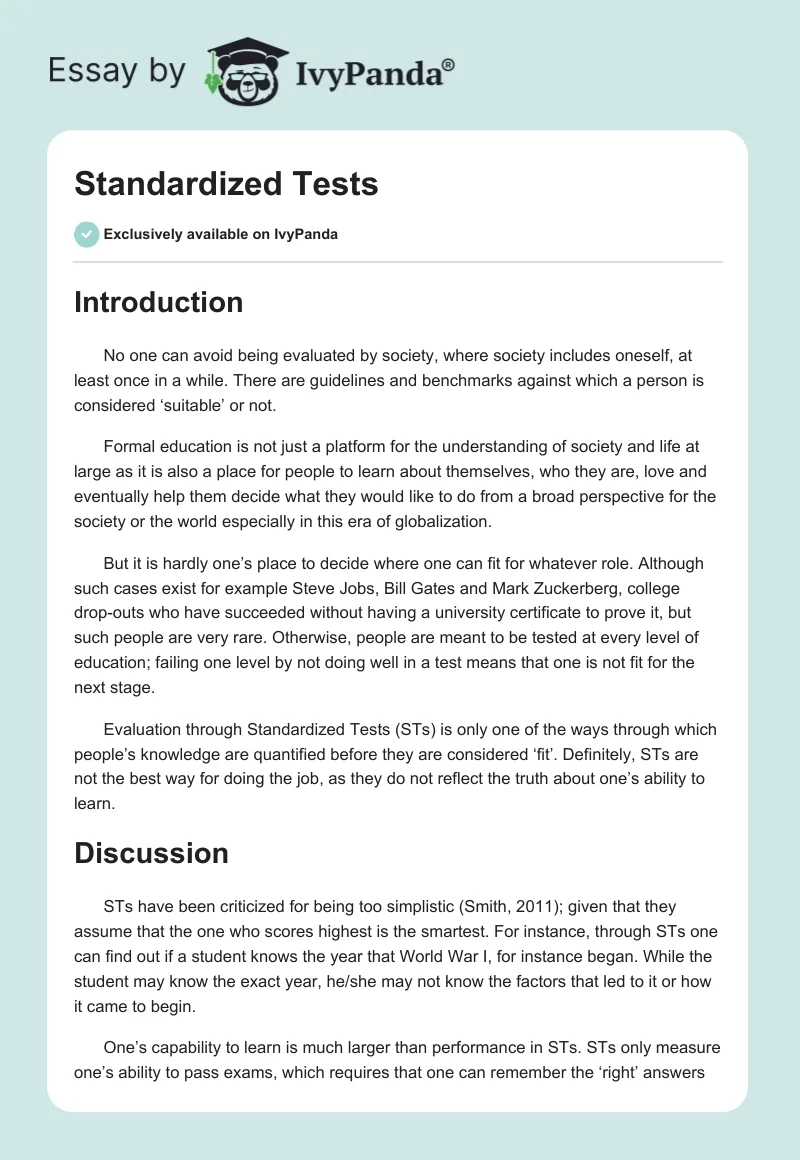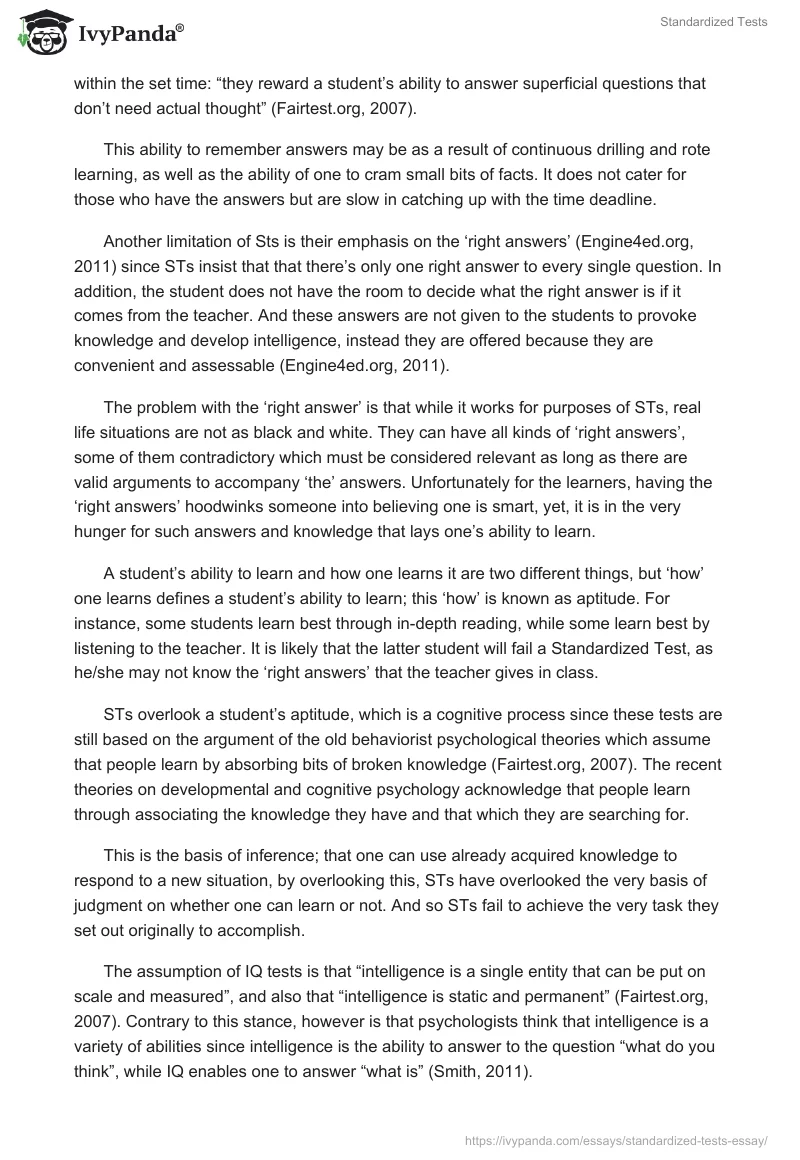Introduction
No one can avoid being evaluated by society, where society includes oneself, at least once in a while. There are guidelines and benchmarks against which a person is considered ‘suitable’ or not.
Formal education is not just a platform for the understanding of society and life at large as it is also a place for people to learn about themselves, who they are, love and eventually help them decide what they would like to do from a broad perspective for the society or the world especially in this era of globalization.
But it is hardly one’s place to decide where one can fit for whatever role. Although such cases exist for example Steve Jobs, Bill Gates and Mark Zuckerberg, college drop-outs who have succeeded without having a university certificate to prove it, but such people are very rare. Otherwise, people are meant to be tested at every level of education; failing one level by not doing well in a test means that one is not fit for the next stage.
Evaluation through Standardized Tests (STs) is only one of the ways through which people’s knowledge are quantified before they are considered ‘fit’. Definitely, STs are not the best way for doing the job, as they do not reflect the truth about one’s ability to learn.
Discussion
STs have been criticized for being too simplistic (Smith, 2011); given that they assume that the one who scores highest is the smartest. For instance, through STs one can find out if a student knows the year that World War I, for instance began. While the student may know the exact year, he/she may not know the factors that led to it or how it came to begin.
One’s capability to learn is much larger than performance in STs. STs only measure one’s ability to pass exams, which requires that one can remember the ‘right’ answers within the set time: “they reward a student’s ability to answer superficial questions that don’t need actual thought” (Fairtest.org, 2007).
This ability to remember answers may be as a result of continuous drilling and rote learning, as well as the ability of one to cram small bits of facts. It does not cater for those who have the answers but are slow in catching up with the time deadline.
Another limitation of Sts is their emphasis on the ‘right answers’ (Engine4ed.org, 2011) since STs insist that that there’s only one right answer to every single question. In addition, the student does not have the room to decide what the right answer is if it comes from the teacher. And these answers are not given to the students to provoke knowledge and develop intelligence, instead they are offered because they are convenient and assessable (Engine4ed.org, 2011).
The problem with the ‘right answer’ is that while it works for purposes of STs, real life situations are not as black and white. They can have all kinds of ‘right answers’, some of them contradictory which must be considered relevant as long as there are valid arguments to accompany ‘the’ answers. Unfortunately for the learners, having the ‘right answers’ hoodwinks someone into believing one is smart, yet, it is in the very hunger for such answers and knowledge that lays one’s ability to learn.
A student’s ability to learn and how one learns it are two different things, but ‘how’ one learns defines a student’s ability to learn; this ‘how’ is known as aptitude. For instance, some students learn best through in-depth reading, while some learn best by listening to the teacher. It is likely that the latter student will fail a Standardized Test, as he/she may not know the ‘right answers’ that the teacher gives in class.
STs overlook a student’s aptitude, which is a cognitive process since these tests are still based on the argument of the old behaviorist psychological theories which assume that people learn by absorbing bits of broken knowledge (Fairtest.org, 2007). The recent theories on developmental and cognitive psychology acknowledge that people learn through associating the knowledge they have and that which they are searching for.
This is the basis of inference; that one can use already acquired knowledge to respond to a new situation, by overlooking this, STs have overlooked the very basis of judgment on whether one can learn or not. And so STs fail to achieve the very task they set out originally to accomplish.
The assumption of IQ tests is that “intelligence is a single entity that can be put on scale and measured”, and also that “intelligence is static and permanent” (Fairtest.org, 2007). Contrary to this stance, however is that psychologists think that intelligence is a variety of abilities since intelligence is the ability to answer to the question “what do you think”, while IQ enables one to answer “what is” (Smith, 2011).
Intelligence includes one’s ability to write, to extract meaning from a text, to comprehend scientific reasoning and methods, to grasp concepts of social science, to use math and apply the same in real life situations.
A student’s ability to learn requires intelligences, not just IQ; STs insists on putting IQ ahead of intelligence. Since they do not allow students to exercise their skills, creativity, critical thinking, reasoning and deductive logic (Smith, 2011). As such it may end up rewarding all the wrong candidates.
There are so many arguments against ST’s approach that it is quite hard to come about documents that favor STs. For instance, proponents of STs argue that they are practical, meaning that they are easy to administer as well as efficient in term s of time and grading; that they prepare students for the college test-taking skills; that they are a consistent means of comparing student aptitude and knowledge; and that they are unbiased in the sense that they are graded by machines, and so test scores are free from subjectivity of the examiners (eCampusour, 2009).
But these arguments look feeble in the face of criticisms that are directed at STs. No one argues against the fact that these tests are efficient; in fact, it is partly the need for this efficiency that STs are there. Opponents of STs are asking that efficiency is not to be emphasized at the expense of students who cannot cram for the sake of tests. But their argument on the objectivity of STs is debatable, if it is true for instance that STs are unbiased when it comes to grading.
But this is just as far as that objectivity goes. However, every other aspect of it is human-manipulated; for instance, the contents and wording of the tests, the determination of the ‘right’ answer, choosing and administration of the test, and how the results are used are decided by ‘subjective’ humans (Fairtest.org, 2007).
The implication of these arguments is that supporters of Standardized tests do not dispute the arguments presented again STs, which could also mean that they agree on these limitations of STs. The only difference is that, for them STs as a form of evaluation is all there is to it and so all they can do is to look on the ‘bright’ side, and avoid the ‘dark’ side of Standardized Tests.
Conclusion
The forwarded limitations of Standardized Tests are real, but it is equally important to note that, before this test can be removed or modified there have to be proposals on what should guide the development and implementation of a possible new system of evaluation. One such factor is that that the next system, either new or a modification of the Standardized test should be able to test intelligence which encompasses a variety of other measures.
As observed by one author “relying on IQ scores without substantiating/proving the findings with the help of other sources of data is a disservice to the students and gives wrong information to policy makers” (Gilman, 2001). Also, the assessments made and the consequent interventions should take into account the differences in individual aptitudes and development (Gilman, 2001). Lastly, tests should be designed as tools that facilitate students to learn and not for ranking and classifying purposes.
In this regard, a close observation of a student by the teacher, tracking and documentation of a student’s work and assessments based on performance can be crucial ingredients. All these should involve an evaluation that directly checks a student’s real learning efforts and tasks, and ultimately provides teachers, parents, communities and the government with useful material for the implementation of such a policy (Fairtest.org, 2007).
References
eCampusour (2009). Arguments for and Against Standardized Testing in College Admissions. Web.
Engine4ed.org. (2011). Problems with Standardized Tests. Web.
Fairtest.org (2007). What’s wrong with Standardized Tests? Web.
Gilman, L. (2001). The Theory of Multiple Intelligences. Web.
Smith, S. (2011). What Are Standardized Tests. Web.


